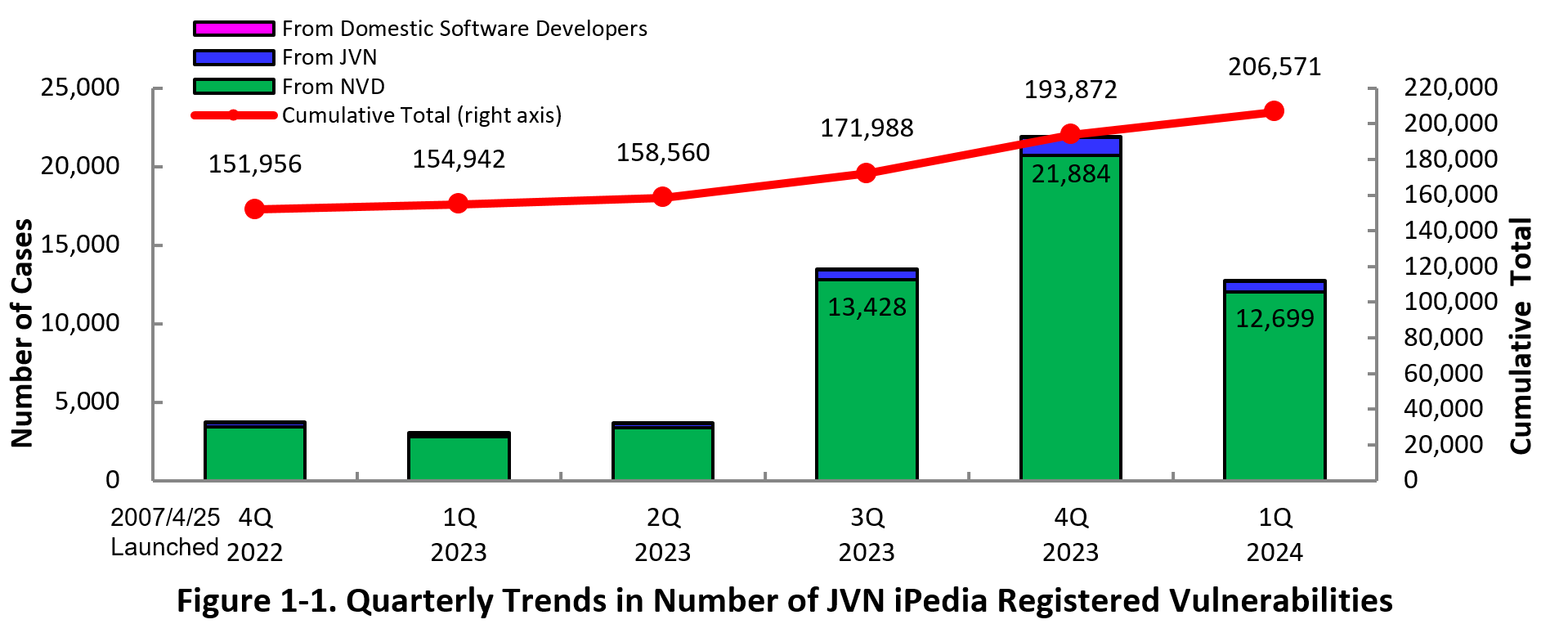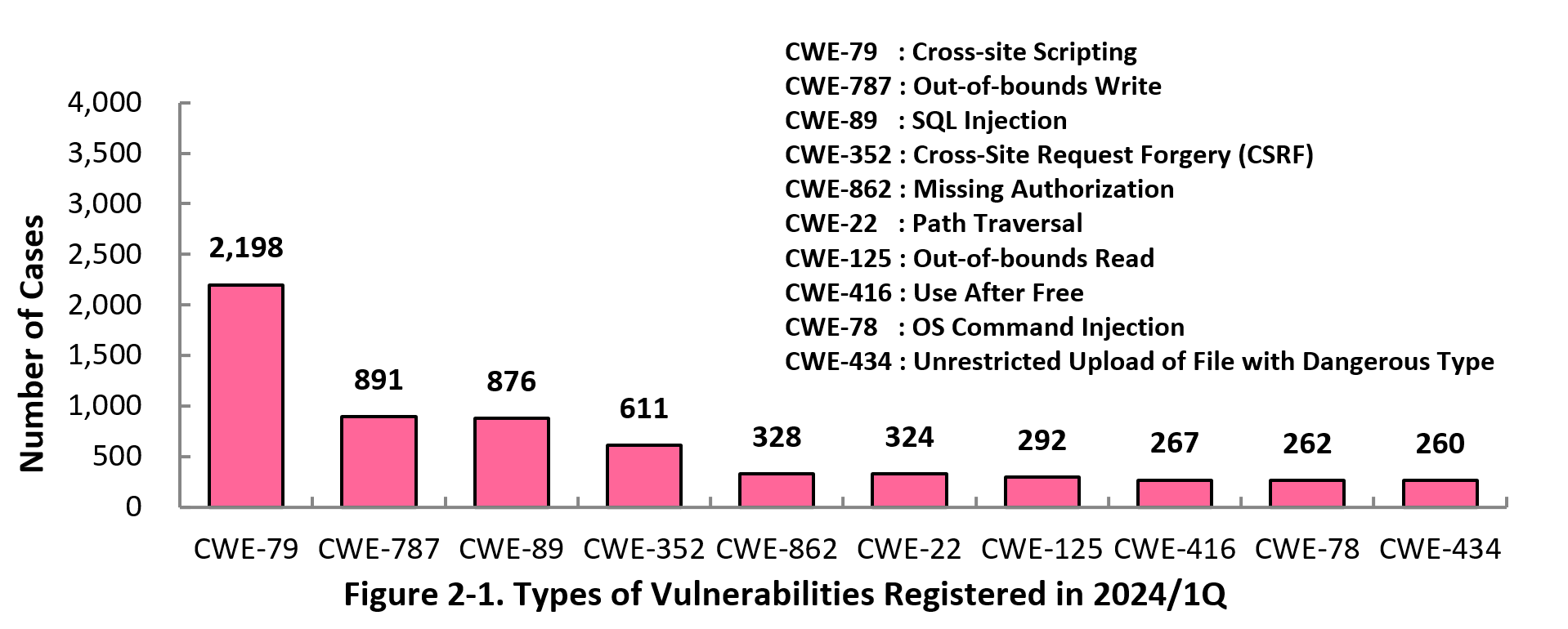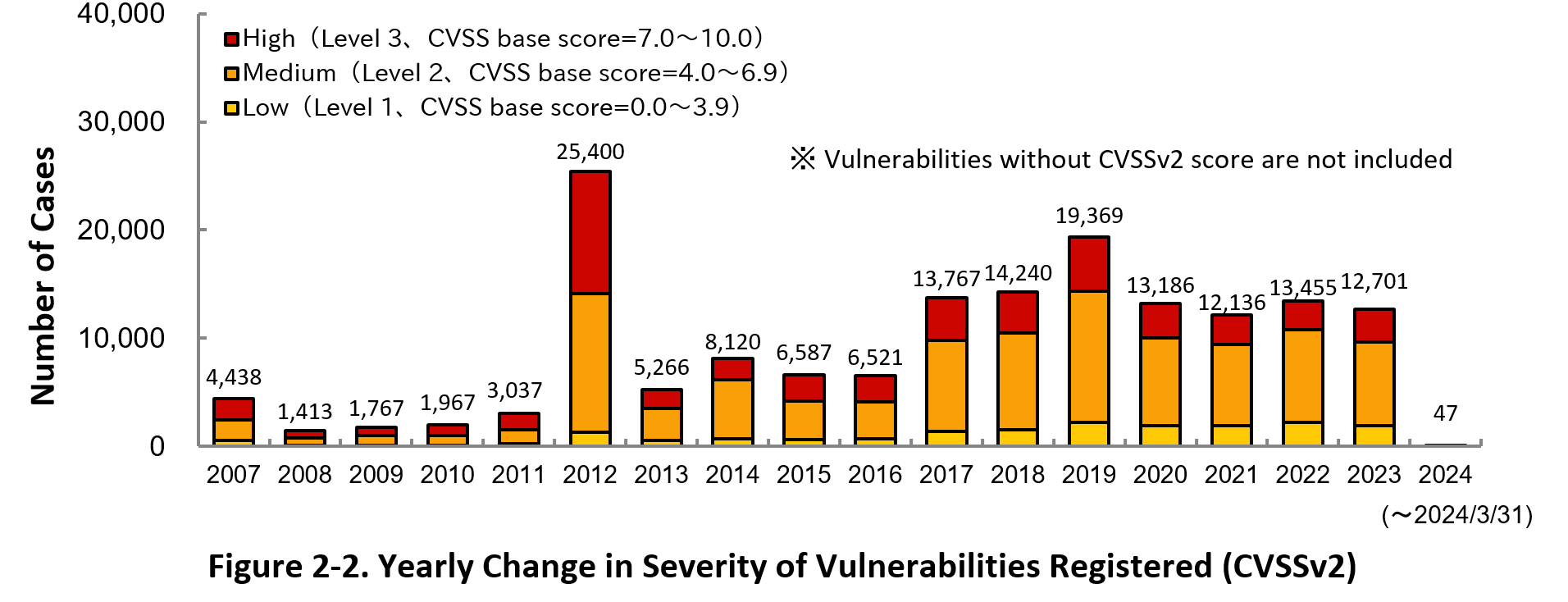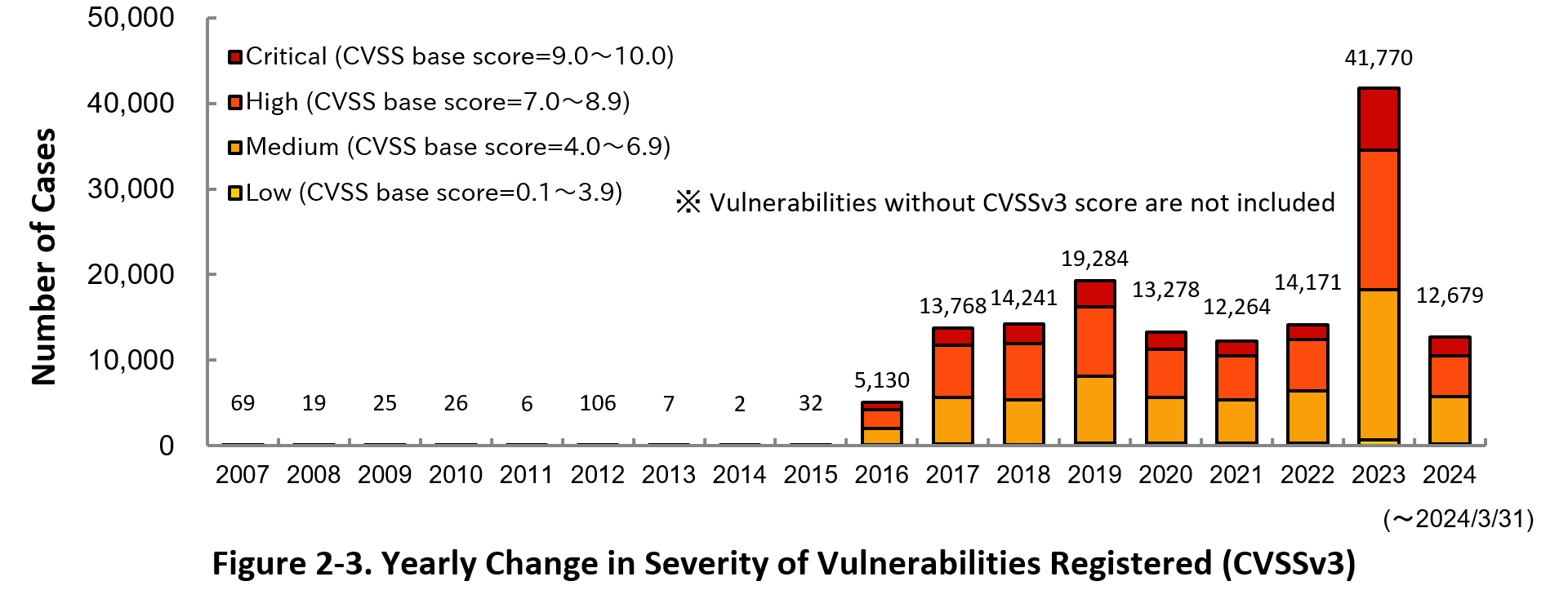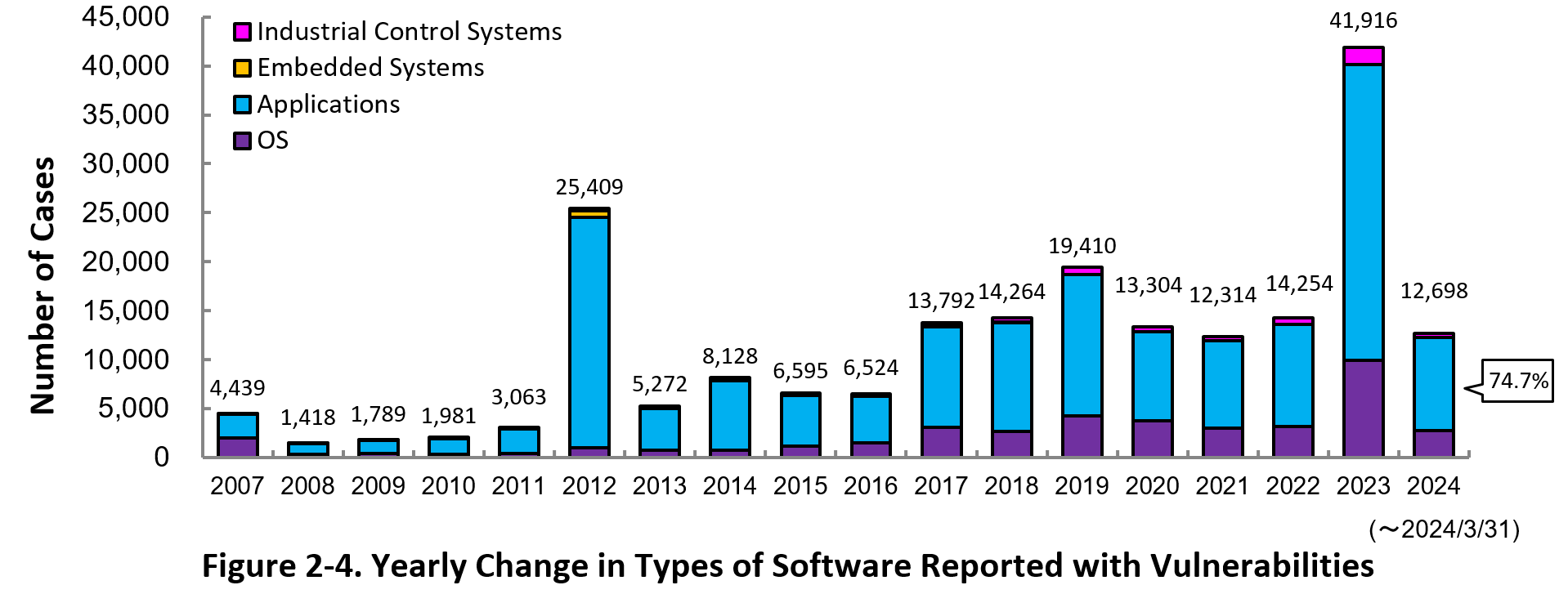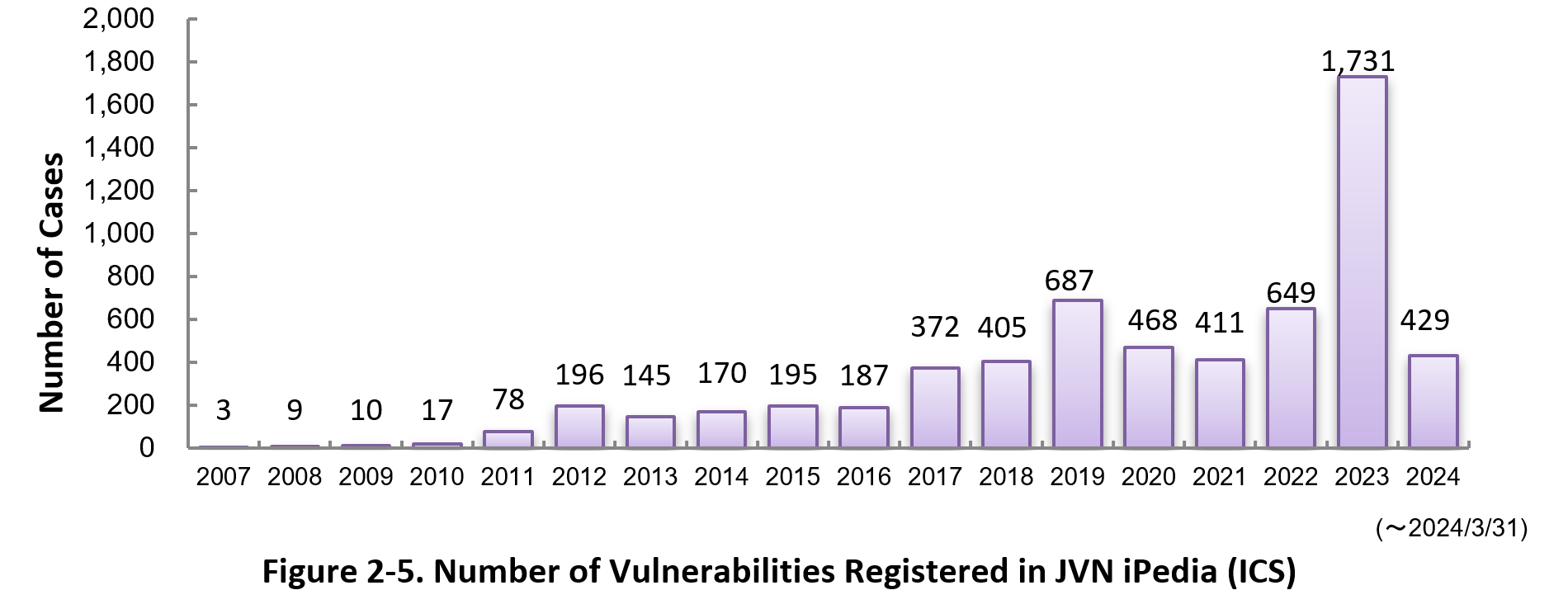Enhancing information security

Vulnerability Countermeasure Information Database JVN iPedia Registration Status [2024 1st Quarter (Jan. - Mar.)]
Release Date:May 22, 2024
IT Security Center
1. 2024 1st Quarter: Vulnerability Countermeasure Information Database JVN iPedia Registration Status
The vulnerability countermeasure information database JVN iPedia is endeavoring to become a comprehensive vulnerability database where vulnerability information is aggregated for easy access for IT users. JVN iPedia collects and/or translates the vulnerability information published by 1) domestic software developers, 2) JVN (footnote 1), a vulnerability information portal run by JPCERT/CC and IPA, and 3) NVD (footnote 2), a vulnerability database run by NIST (footnote 3). JVN iPedia has been making vulnerability information available to the public since April 25, 2007.
1-1. Vulnerabilities Registered in 2024/1Q
JVN iPedia now stores 206,571 vulnerabilities
The summary of the vulnerability information registered to the Japanese version of JVN iPedia during the 1st quarter (January 1 to March 31) of 2024 is shown in the table below. As of the end of March 2024, the total number of vulnerabilities stored in JVN iPedia is 206,571 (Table 1-1, Figure 1-1).
The number of vulnerabilities registered in JVN iPedia has been increased significantly since the third quarter of 2023, but that doesn't mean that more vulnerabilities have been discovered in the world during this period.
As for the JVN iPedia English version, the total number of vulnerabilities stored is 2,787 as shown in the Table 1-2.
Table 1-1. Vulnerabilities Registered in JVN iPedia during 1st Quarter of 2024 (Japanese Version)
| Information Source | Registered Cases | Cumulative Cases |
|---|---|---|
| Domestic Software Developers | 5 cases | 280 cases |
| JVN | 684 cases | 15,239 cases |
| NVD | 12,010 cases | 191,052 cases |
| Total | 12,699 cases | 206,571 cases |
Table 1-2. Vulnerabilities Registered in JVN iPedia during 1st Quarter of 2024 (English Version)
| Information Source | Registered Cases | Cumulative Cases |
|---|---|---|
| Domestic Software Developers | 5 cases | 284 cases |
| JVN | 58 cases | 2,503 cases |
| Total | 63 cases | 2,787 cases |
2. Details on JVN iPedia Registered Data
2-1. Types of Vulnerabilities Reported
Figure 2-1 shows the number of vulnerabilities newly added to JVN iPedia during the 1st quarter (January 1 to March 31) of 2024, sorted by the CWE vulnerability types.
The type of the vulnerabilities reported most in the 1st quarter is CWE-79 (Cross-Site Scripting) with 2,198 cases, followed by CWE-787 (Out-of-bounds Write) with 891, CWE-89 (SQL Injection) with 876, CWE-352 (Cross-Site Request Forgery) with 611, CWE-862 (Missing Authorization) with 328. CWE-79 (Cross-site Scripting), the most reported vulnerability type in this quarter, could allow attackers to display false webpages and/or steal information.
Software developers need to make sure to mitigate vulnerability from the planning and design phase of software development. IPA provides tools and guidelines, such as “Vulnerability Countermeasure Guide for Software Developers” (footnote 4), “How to Secure Your Web-site” (footnote 5), and “AppGoat” (footnote 6), a hands-on venerability learning tool, for website developers and operators to build secure websites.
2-2. Severity of Vulnerabilities Reported
Figure 2-2 shows the yearly change in the CVSSv2 rating scale based severity of vulnerabilities registered to JVN iPedia.
As for the vulnerabilities added to JVN iPedia in 2024, 4.2 percent are “Level 3” (7.0 - 10.0), 66.0 percent are “Level 2” (4.0 – 6.9) and 29.8 percent are “Level 1” (0.0 – 3.9). This means 70.2 percent of all vulnerabilities registered are Level 2 or higher, which are potentially critical enough to cause damage like information exposure or data falsification.
The reason for the significant decrease in the number of CVSSv2 registrations in JVN iPedia in 2024 is that CVSSv2 is not actively evaluated by NVD, the information collection source for JVN iPedia (footnote 7).
Figure 2-3 shows the yearly change in the CVSSv3 rating scale based severity of vulnerabilities registered to JVN iPedia.
As for the vulnerabilities added to JVN iPedia in 2024, 17.1 percent are “Critical” (9.0 – 10.0), 37.6 percent are “High” (7.0 – 8.9), 43.8 percent are “Medium” (4.0 – 6.9) and 1.5 percent are “Low” (0.1 – 3.9).
To avoid threats posed by the known vulnerabilities, both product developers and IT users should pay close attention to vulnerability disclosure and update software they use to a fixed version or apply a security patch as soon as possible when they become available. IT users can check vulnerabilities newly published on JVN iPedia in RSS and XML format (footnote 8) as well.
2-3. Types of Software Reported with Vulnerability
Figure 2-4 shows the yearly change in the type of software reported with vulnerability. Application vulnerabilities have been published most, accounting for 74.7 percent (9,481 out of 12,698) of the 2024 total.
Figure 2-5 shows the yearly change in the number of JVN iPedia-stored vulnerabilities in industrial control systems (ICS) used in critical infrastructure sectors. As of March 2024, the total of 6,162 ICS vulnerabilities have been registered.
2-4. Products Reported with Vulnerability
Table 2-1 lists the top 20 software whose vulnerabilities were most registered to JVN iPedia during the 1st quarter (January 1 to March 31)of 2024.
In this quarter, the most registered product was the Qualcomm component. After the second place, a wide range of venders' OS products were on the list, such as Google, Apple, and Microsoft.
Besides those in the top 20 list, JVN iPedia stores and offers vulnerability information about a variety of software. IPA hopes software developers and users will make good use of JVN iPedia to efficiently check vulnerability information and take necessary action in a timely manner (footnote 9).
Table 2-1. Top 20 most registered software products vulnerability countermeasure information in JVN iPedia [Jan. – Mar. 2024]
|
Rank
|
Category
|
Product Name (Vendor)
|
Number of
Vulnerabilities Registered |
|---|---|---|---|
|
1
|
Firmware
|
Qualcomm component (Qualcomm) |
2,889
|
|
2
|
OS
|
Android (Google) |
521
|
|
3
|
OS
|
macOS (Apple) |
292
|
|
4
|
OS
|
Fedora (Fedora Project) |
236
|
|
5
|
OS
|
Linux Kernel (Linux) |
203
|
|
6
|
CMS
|
Adobe Experience Manager (Adobe) |
199
|
|
7
|
OS
|
Debian GNU/Linux (Debian) |
194
|
|
8
|
OS
|
iPadOS (Apple) |
183
|
| 8 | OS | iOS (Apple) | 183 |
|
10
|
Browser
|
Google Chrome (Google) |
157
|
|
11
|
Browser
|
Mozilla Firefox (Mozilla Foundation) |
148
|
|
12
|
OS
|
Red Hat Enterprise Linux (Red Hat) |
126
|
|
13
|
CMS
|
Adobe Experience Manager Cloud Service (Adobe) |
117
|
|
14
|
OS
|
HarmonyOS (Huawei) |
116
|
|
15
|
OS
|
EMUI (Huawei) |
110
|
|
16
|
OS
|
watchOS (Apple) |
99
|
|
17
|
Browser
|
Mozilla Firefox ESR (Mozilla Foundation) |
87
|
|
18
|
Others
|
GTKWave (tonybybell) |
82
|
|
19
|
OS
|
Microsoft Windows Server 2022 (Microsoft) |
80
|
|
20
|
OS
|
tvOS (Apple) |
79
|
3. Most Accessed Vulnerability Countermeasure Information
Table 3-1 lists the top 20 most accessed vulnerability countermeasure information in JVN iPedia during the 1st quarter (January 1 to March 31) of 2024.
This quarter's list includes 17 vulnerability countermeasure information published in Japan Vulnerability Notes (JVN), the vulnerability countermeasure information portal.
Table 3-1. Top 20 Most Accessed Vulnerability Countermeasure Information in JVN iPedia [Jan. – Mar. 2024]
|
Rank
|
ID/Title
|
CVSSv2
Base Score
|
CVSSv3
Base Score
|
Publication Date
|
Access Count |
|---|---|---|---|---|---|
|
1
|
4.0
|
5.0
|
2024/1/12
|
6,915
|
|
|
2
|
-
|
9.8
|
2024/2/7
|
6,616
|
|
|
3
|
JVNDB-2023-012042
|
-
|
9.8
|
2023/12/15
|
6,513
|
|
4
|
JVNDB-2024-000028
|
4.3
|
7.8
|
204/3/7
|
6,020
|
|
5
|
JVNDB-2022-012258
Jforum by the JForum Team vulnerable to cross-site request forgery (in Japanese only) |
6.8
|
8.8
|
2023/8/28
|
6,011
|
|
6
|
JVNDB-2024-001002
|
-
|
7.5
|
2024/1/10
|
5,814
|
|
7
|
JVNDB-2024-000013
|
2.1
|
4.0
|
2024/1/23
|
5,610
|
|
8
|
JVNDB-2024-002837
Windows kernel elevation of privilege vulnerability in multiple Microsoft Windows products (in Japanese only) |
-
|
7.8
|
2024/2/22
|
5,566
|
|
9
|
JVNDB-2024-000004
|
5.0
|
5.3
|
2024/1/16
|
5,490
|
|
10
|
JVNDB-2024-000020
|
3.5
|
4.8
|
2024/2/20
|
5,465
|
|
11
|
JVNDB-2023-000126
|
3.5
|
5.4
|
2023/12/26
|
5,374
|
|
12
|
3.5
|
5.4
|
2023/8/21
|
5,343
|
|
|
13
|
JVNDB-2024-000011
|
4.3
|
6.1
|
2024/1/22
|
5,335
|
|
14
|
JVNDB-2024-001062
|
5.2
|
6.8
|
2024/1/24
|
5,328
|
|
15
|
1.7
|
2.1
|
2024/1/15
|
5,301
|
|
|
16
|
JVNDB-2023-000125
|
5.2
|
6.8
|
2023/12/26
|
5,189
|
|
17
|
JVNDB-2024-000005
|
4.3
|
3.3
|
2024/1/24
|
5,152
|
|
18
|
2.6
|
6.5
|
2024/3/6
|
5,141
|
|
|
19
|
JVNDB-2024-002832
|
-
|
7.6
|
2024/2/21
|
5,122
|
|
20
|
JVNDB-2024-002942
|
-
|
7.2
|
2024/3/8
|
5,109
|
Table 3-2 lists the top 5 most accessed vulnerability information among those reported by domestic software developers.
Table 3-2. Top 5 Most Accessed Vulnerabilities Reported by Domestic Product Developers [Jan. - Mar. 2024]
|
Rank
|
ID/Title
|
CVSSv2
Base Score
|
CVSSv3
Base Score
|
Publication Date
|
Access Count |
|---|---|---|---|---|---|
|
1
|
JVNDB-2024-002832
|
-
|
7.6
|
2024/2/21
|
5,122
|
|
2
|
-
|
7.9
|
2024/1/31
|
4,711
|
|
|
3
|
JVNDB-2024-002961
|
-
|
5.6
|
2024/3/13
|
3,829
|
|
4
|
-
|
8.4
|
2023/10/4
|
3,100
|
|
|
5
|
JVNDB-2023-009619
|
-
|
-
|
2023/12/6
|
2,961
|
Footnotes
(1) Japan Vulnerability Notes: A portal for vulnerability countermeasure information including information on vendor response to the reported vulnerabilities and security support. Operated in the collaboration of IPA and JPCERT/CC.
(2) National Vulnerability Database: A vulnerability database operated by NIST.
(3) National Institute of Standards and Technology: A U.S federal agency that develops and promotes measurement, standards and technology.
(4) Vulnerability Countermeasure Guide for Software Developers (in Japanese only)
(5) How to Secure Your Websites (latest version in Japanese only)
(6) AppGoat (in Japanese only)
(7) NIST - "Retirement of CVSS v2"
(8) IPA Data Feeds (in Japanese only)
(9) IPA Technical Watch - Daily Practice Guide (in Japanese only): Tips on Vulnerability Management The guide gives tips on how to efficiently collect and leverage vulnerability information.
Past Quarterly Reports
Contact information
IT Security Center,
Information-technology Promotion Agency, Japan (ISEC/IPA)

